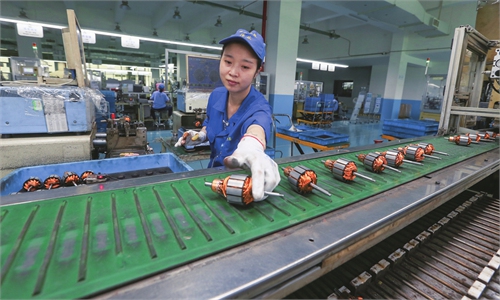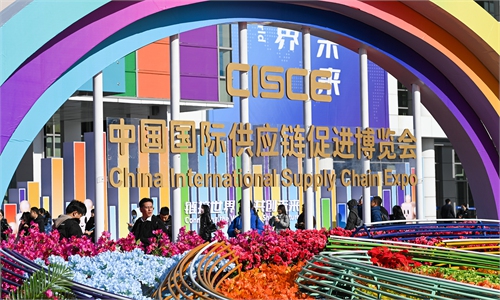
Illustration: Chen Xia/Global Times
China's annual Central Economic Work Conference, held in Beijing last week, has garnered extensive attention from the world for its importance in setting the roadmap and targets for the country's economic development next year. At the meeting, Chinese policymakers are seen setting their eyes squarely on revolutionary new technologies that will lead China's next-phase efforts toward realizing Chinese-style modernization.In a headline statement, the economic conference called for non-stop and strenuous efforts to promote the country's industrial and service sector upgrading through consistent innovations in science and technology, and in particular, to forge new levers of growth and seek more advanced and efficient business models that are backed up with cutting-edge technologies, such as deep digital-domain research and breakthroughs in artificial intelligence and automation.
It is well known that China, since 1980, has frog-leaped in high-tech exploration, leading to rapid industrialization. This is evident in the country's spectacular achievements in manufacturing various industrial products, such as heavy machinery, home appliances, 4G and 5G telecom equipment, high-speed trains, commercial aerospace exploration, and now, the production of green-energy products like solar panels, wind turbines, nuclear power reactors and electric vehicles.
Chinese policymakers have demonstrated foresight and even prophetic vision by prioritizing constant technological innovation as a means to propel the country's modernization and enhance its comprehensive national strength. This approach not only allows China to prosper but also enables the country to support the growth of other developing nations through initiatives like the Belt and Road Initiative (BRI).
In 2024, more financial and human resources will be deployed to inspire both state-run research institutes and privately-owned companies to achieve breakthroughs in crucial technologies. This is part of Beijing's determined effort to cultivate new and powerful drivers of economic growth, despite external challenges and geopolitical volatility orchestrated by certain countries.
Detailed measures may include leveraging the government's special bonds to support innovation by all types of business groups and research organizations, while motivating private high-tech companies in the country to participate in key innovation projects such as high-end batteries, semiconductors, robotics and industry-leading software such as advanced autonomous driving solutions, AI solutions and quantum computing breakthroughs.
It is of the utmost significant for Chinese policymakers to focus on technological innovations to seek new productivity boosters and consistently enhance the country's overall global competitiveness. Additionally, grasping new technologies could also help China avoid sliding into the "middle-income trap."
For a protracted period of time through the 1970s to the 1990s, neoliberals in the US trumpeted the so-called Washington Consensus, inducing Latin American countries to adopt orthodox theories including the concept of "comparative advantage." This theory suggests that countries should engage in trade with each other by exporting goods in which they have a relative advantage.
The theory led many developing countries in Latin America and elsewhere to focus on exporting agricultural produce and extractive goods, as well as low-skilled, labor-intensive basic industrial products, in exchange for high-value-added products made in the US, Japan and other developed economies. As a result, many countries in Latin America and the broader Global South have failed to make significant progress in raising the overall quality of life.
Although the Global South's less-developed countries have a "comparative advantage" in producing agricultural and extractive goods, or primary mass-produced industrial goods like shoes, shirts and toys, they can hardly compete with the "absolute advantage" of high-tech industries owned by the US and other developed countries.
If China had followed the outdated principles of "comparative advantage" theory, its economy would not have reached its current high level, and it would have been unable to compete with the US, Japan, the UK, and others in technology-led industrial competition. For example, China wouldn't have been able to build the world's most advanced high-speed railway system which currently spans over 43,000 kilometers.
It also explains why the US has cajoled its core allies to crack down on Huawei, SMIC and other leading high-tech companies in China, in order to maintain and strengthen its "absolute advantage" industries. Washington is particularly concerned and nervous about Huawei's unique capabilities in 5G, AI, microchip design, high-end software development such as the Harmony series operating system, and most recently, advanced autonomous-driving solutions.
Over the past several years, China has faced strong headwinds to climb the technology ladder as the US government, wary of China's fast technological rise, gripped its allies together to impede and suppress China's advance in manufacturing high-end semiconductor chips and AI development. An increasing number of Chinese high-tech enterprises and research institutes have been placed on the US Commerce Department's "Entity List," with their US supplies cut off. And, in 2022, the Biden administration and the US Congress adopted and passed the CHIPS and Science Act and the Inflation Reduction Act to enhance the US' manufacturing capability in semiconductors, batteries and electric vehicles in order to outdo China in future competition.
But China is determined to shore up technological self-reliance, because it knows that leading technologies cannot be bought or begged. It is deploying important resources to ramp up innovation in all fields of new technology innovations, as the country would have little chance of becoming a successful player in future high-tech industrial and national strength contest if it falters in innovation.
Deeply aware of the truth that science and technology is the first productivity, China didn't follow the dogmatic "comparative advantage" constraints, and opted for the pragmatic results-oriented economic development road. Today the country is able to compete with the US and other advanced economies in both mass industrial consumption goods and other high-tech intensive goods. And, an incomplete study finds that, of its total manufactured exports last year, about 30 percent are value-added high-tech products, one of the highest in the world.
To continuously ratchet up the country's technological development levels, China should adhere to maintaining the traditional high standards of its education system, focus on new technology study, research and innovation, and unwaveringly upgrades the country's R&D levels to prevail in upcoming fiercer economic competition.
The author is an editor with the Global Times. bizopinion@globaltimes.com.cn



